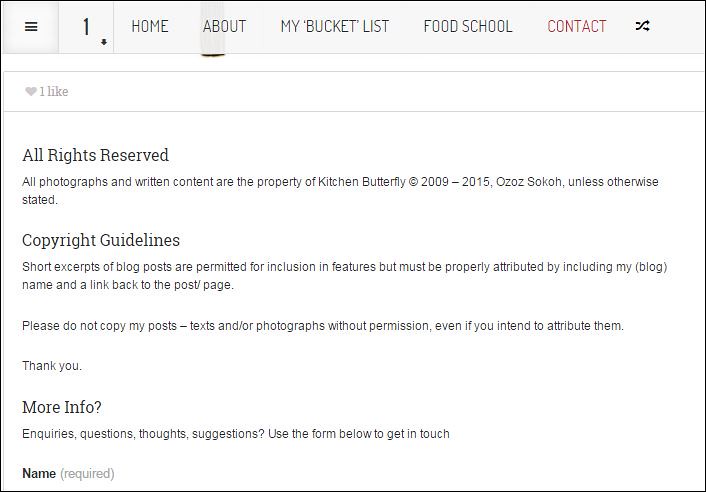I didn’t understand the gravity of Intellectual Property till I started creating recipes. Till I walked down circuitous paths in my head and in market stalls, on paper, in speeches and in many other places.
In 2009, I attended a Food Bloggers Conference where Jeanne of Cooksister shared with us the importance of valuing our copyrights. She reminded me that I should treat my IP with respect by establishing and publicising my rights – on my photos and my blog.
Because of that, I put up a copyright notice in the foot of the homepage.

A few years later, someone began copying whole blog posts of mine. I had to contact Google who eventually took that blog down and that led me to put up a notice in my Contact page about rights and guidelines.
Do I still have my work stolen? Yes. By all manners of people. But first, let’s talk Intellectual property.
What is it? Is it the idea? In a generic sense, no.
For it to translate generality, you have to execute the idea. If you have an idea for a recipe and then go on to make it, photography it, write about it – you have developed intellectual property. So it isn’t the idea alone but the result and its manifestation.
Lets use this as an example: I had an idea – do something with pumpkins. Make curries, bake pies, blend into smoothies and lattes.
But…it became intellectual property when I developed the recipe for a Pumpkin Goat Curry, cooked it, photographed it and shared it on my blog. If someone copies this recipe wholly, they have breached/ infringed my copyrights and ‘stolen’ my intellectual property.
“Copyright law does not protect recipes that are mere listings of ingredients….. Copyright protection may, however, extend to substantial literary expression—a description, explanation, or illustration, for example—that accompanies a recipe or formula or to a combination of recipes, as in a cookbook; Paleomagazine”
There are a few ways people could reference this work within legal confines:
- Ask for permission to use the recipe/ information contained in the post. In this case, if granted, content could be used as is or as specified, with clear attribution
- ‘Reference work’, through a mention of ‘inspired by’ or include short excerpt providing link back to post, with clear attribution
Of course there are many, many shades in between but you should always seek permission, properly reference a work that has provided inspiration and content or in the case of Fair Use, not derive financial gain from it.
What then is ‘Fair Use’ I hear you ask? Essentially? Non-financial gain. According to Stanford University Libraries, ‘In its most general sense, a fair use is any copying of copyrighted material done for a limited and “transformative” purpose, such as to comment upon, criticize, or parody a copyrighted work. Such uses can be done without permission from the copyright owner. In other words, fair use is a defense against a claim of copyright infringement. If your use qualifies as a fair use, then it would not be considered an illegal infringement.’
If your work is used where there is commercial gain, then it doesn’t comply with ‘fair use’.
Useful reading
Intellectual Property & Copyright guidelines
Using copyrighted work – Fair Use & Permissions
[wpurp-searchable-recipe]Recipes: Intellectual Property & ‘Copyright’ Protection? – – – [/wpurp-searchable-recipe]



Leave a Reply